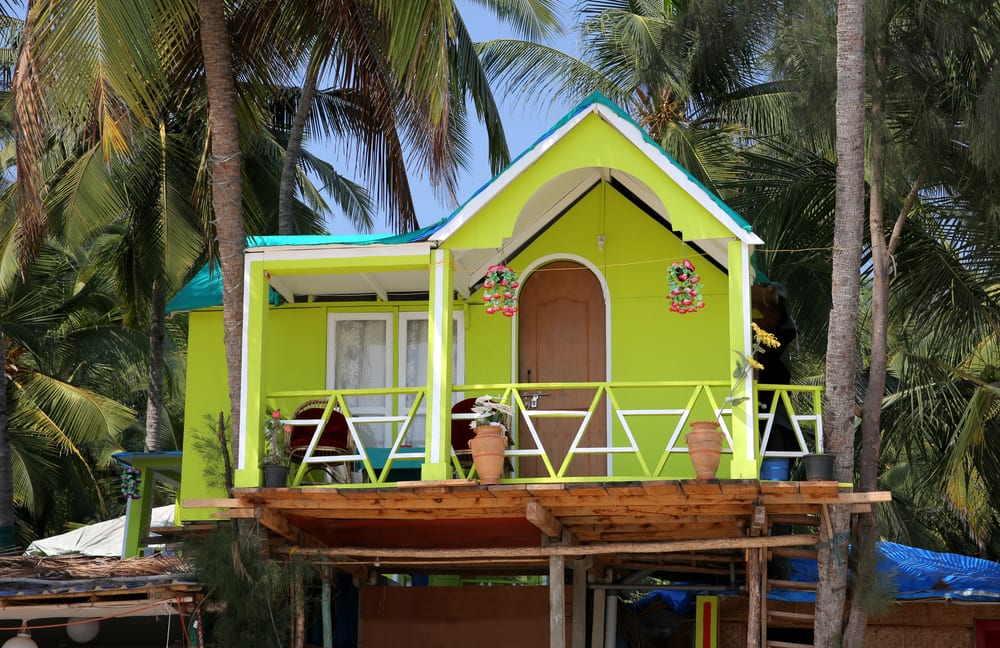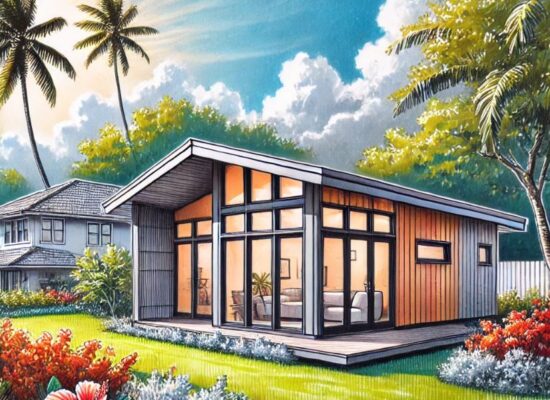- How to Optimize Space In Your New ADU
- Just How Big is a 400 sq ft ADU?
- What is an Accessory Dwelling Unit?
- What’s the 411 with Hawaii ADUs?
- What’s the 411 with Hawaii ADU’s: The FAQs Continued
- The Benefits of Building an ADU on Your Property
- Why Are ADUs So Important in Hawaii?
- Why ADUs Make Financial Sense
- Six Questions to Ask Yourself Before You Build an ADU in Hawaii
- The 9 Basic Requirements for Building an ADU in Hawaii
- Retirement Downsizing in Place with an Accessible ADU
Since the dawn of property ownership, people have been building smaller dwellings near their pre-existing homes. In Australia, they call them Granny Flats, in certain parts of the continental US, they’re called Mother-in-Law houses and here in Hawaii, the official term is ADU, short for Accessory Dwelling Unit. Like the acronym says, these are little homes that act as complete residential unit accessories to a main house on a shared property. Theoretically, anyone can build an ADU simply by making a nice addition or building with a kitchen, bedroom, and bathroom but officially there are certain legal guidelines for an approved ADU construction. Before you break out your carpentry tools or call a contractor, make sure your home and plans conform to the 9 basic requirements for building an ADU.
1) Proper Zoning
Zoning in Hawaii and knowing your exact zone can be a little tricky and ADUs can only be built in six specific zones. Before even thinking about building one of these tiny separate houses, make sure to check your lot’s zone by address and ensure that it matches one of the following:
- R-3.5
- R-5
- R-7.5
- R10
- R20
- Country District
2) Lot is At Least 3,5000 Square Feet
To ensure that there is plenty of room for your ADU, anyone who wants to build one needs to have a house lot that reaches at least 3,500 square feet of space. Fortunately, your original house is allowed to sit on some of it. Rather than breaking out the incredibly long measuring tape, you can check your lot’s size online to figure out if you qualify. Bigger is always better, and you’ll find out why with point nine.
3) Lot is Not Landlocked
To build an ADU, your lot will need to actually make contact with the road. Due to certain access requirements, a landlocked lot cannot hold an ADU. However, you can have an ADU if your lot is connected via driveway to the road by way of an easement through another closer lot. Flag lots are also perfectly fine.
4) Lot Has One Current Dwelling
You cannot build an ADU unless there is only one complete dwelling on your lot. This means that duplexes, apartment buildings, and lots that already have two or more homes on them cannot build an ADU. However, renovated apartments above the garage or in the basement are just fine as long as they’re not legally a second dwelling.
5) Owner or Family Lives On the Lot
To qualify for ADU construction, the homeowner or at least one member of their family needs to live on the lot when the ADU is complete. This means they can either live in the main house or the ADU based on preference, as long as the owner or a family member is in residence. You are allowed to rent out whichever building you’re not going to live in.
6) Record Your Covenants
When you do build an ADU, you are required to record covenants with the land with either the Bureau of Conveyances or the Land Court of the State of Hawaii or both. This ensures that you will never sell the ADU separately from the rest of the property and the lot cannot be subdivided into two separate properties. There are also other related rules in the Declaration of Restrictive Covenants.
7) No ADU Covenant Restrictions
Check any private covenant signed for your land to ensure that it doesn’t prohibit an ADU. If you have already agreed not to build one, starting construction now would be both illegal and quite silly. However, you may not be aware that the prohibition exists to make sure to check with your HOA to be sure.
8) Room For One More Parking Space
An ADU is officially an entirely separate second dwelling and because of this, it’s expected that the resident is likely to have their own car. Therefore to build a legal ADU, you’ll need room within the lot’s parking areas for one more parking space than your lot’s minimum spaces unless the edge of your property is within a half mile of a rail station.
9) ADU Plans Meet Maximum Size
The maximum square foot area of your ADU is limited by the square footage of the lot itself. There is also a minimum lot size for ADU’s which is 3,500 SF. On lots of this size and up too 4,999 SF your ADU can be 400 square feet maximum.
For lots 5,000 SF and larger, your ADU can be built up to 800 SF maximum.
By the end of this list, you should have a fairly good idea of whether or not you’re legally allowed to build an ADU on your property in addition to your single-family home. If you do decide that an ADU is right for you, your lot, and your family contact us today! We’ll be happy to help you figure out the next steps.
 Copyright secured by Digiprove
Copyright secured by Digiprove 




29 thoughts on “The 9 Basic Requirements for Building an ADU in Hawaii”
Hi. You mention that for lots above 5K, an ADU greater than 800 sq ft is possible. All other information sources I read state that 800 sq ft is the largest for lots above 5K. Can you clarify? thanks.
Thank you for pointing this out Ryan. I have corrected this post. The max. ADU size is 800 SF regardless of bigger lot sizes.
Our existing home has a 2 car covered garage and 2 uncovered parking spaces behind the 2 covered spaces. My husband and I are retired and we each have our own car. We plan to build an ADU for my 88 year old mother who doesn’t drive. Do we still need to create another parking space even though we don’t need it. The ADU we plan to build is 430 sqft. Are we still required to create another parking space on our property?
Hi Bryan, the only provision I am aware of that would eliminate the parking requirement is if it is located within a certain distance to a proposed rail station. Unfortunately they look at the parking requirement as part of the property rather than the tenant need. The parking you have may be enough though, it depends on the square footage of the main dwelling. If it is less than 2,500 SF you only need two for that dwelling, so you could use one of the other stalls you have for the ADU.
Call me if you need more info.
Aloha,
Jim
(808) 383-4632
Legally established dwelling units that are rented for periods of 30
consecutive days or more at any one time. – this is a excerpt from the new bill89 ordinance passed recently. can you comment about the legality of being an owner/occupier on a lot (house) that wishes to have roommates, long term (6m-1year leases for example) but not having a dedicated ADU on the lot?
Hi Adrian, I have no info on this one.
Hi Jim,
Does the 800 sq. max apply to Hawaii County? Or is this an Oahu thing? Is there somewhere this regulation is posted officially?
I’m not sure about Hawaii county Mike, I suggest you call the planning office there to be sure.
How do I find out my lots current number of parking stalls in order to determine whether or not I will need additional parking to build the ADU?
Hi Joe, the ADU will almost always need it’s own parking stall that is not blocking or is blocked by the parking for the main dwelling.
I am looking to purchase a house with a rental….I found one but the second rental building is / has not been legally permitted. i called the housing permit dept and they said that there was a process to get it permitted……does this include lot size? i think the lot is only 6,500 sq ft. What can i do?
Thanks you, jude
Hi Jude, I don’t have enough info to give you a good answer but whatever is built needs to be drawn up and submitted for the permit review/approval. If they issue a notice of violation they will double most of the permit fees. If it does not meet code it would need to be modified or torn down. Lot size is only one factor in determining if the property will qualify for an ADU. Here is a link with resources that explains the ADU requirements. If you want to call me for more info about permitting as-built work please do.
Aloha, Jim
http://ownerbuiltdesign.com/honolulu-adu-guide-report-covenants-downloads/
my family is considering an adu on our property. our lot meets the requirement for an 800 sq ft. unit. we wanted to build it above a garage. are there any restrictions for this? also, are there any restrictions for adding an uncovered porch to the adu?
Hi Austin, I apologize for the slow response. The best way to know for sure if the property qualifies is to submit the ADU precheck form for approval. DPP reviews it for free and it only takes them a couple weeks to process it. Here is the link to download it, http://www.honoluludpp.org/Portals/0/pdfs/construction/ADU%20Pre-Check%20Form%202016.pdf
Aloha,
Jim
Hello Jim.
We have a detached 2 car garage that we are looking at adding an adu on top of it (2nd story apt) Our lot meets all the requirements, but someone has told me that the max hight for an adu is 15′. Based on most of the reading i have done i have not seen this stipulation, but rather seen the height restrictions are 25′-30′ Would you be able to weigh in on this.
Cheers,
Ryan
Hi Ryan, that 15′ height info is incorrect. Here is the page out of the Land Use Ordinance that explains the setback and building height restrictions. https://i.postimg.cc/N0K7cLM2/Residential-setbacks-and-heights.png
Aloha,
Jim
Does Kawaii have a limit of 800sf for ADU ? Can the family who owns the “farmhouse” sell the ADU to an unrelated person? Thanks
Hi Brian, I am not sure about Kauai so I would need to research this a bit. The way the law is on Oahu is that you cannot sell the ADU as a separate unit.
Aloha,
Jim Kane
Is the sq footage of the ADU added to the total sq footage of the main house? for example my lot is 5000sq ft,my main house is at its max sq ft of 2500sq ft. Can I still build a 800sq ft ADU?
Hi Micah, you are speaking about the lot coverage which in the R- zones is 50% total, that would include the main dwelling, ADU, garages, lanais, etc. So the short answer is that you could not build anything that would cover the lot more than the 2,500 SF. However you could go over (2nd story) and that would not add to the lot coverage.
Aloha,
Jim
Hi Jim
Thanks for hosting this very informative site and blog.
If a house has a legal in law unit built on the bottom floor of a two-story home could a detached ADU still be built? The lot itself is 7750sf so it meets the requirements for up to 800sf ADU.
Aloha Gee, in Hawaii only one additional dwelling unit is permitted. ADUs are not permitted on lots that already have more than one dwelling unit. You can learn more about this on this FAQ page, https://ownerbuiltdesign.com/honolulu-adu-guide-report-covenants-downloads/
Can one build their ADU first (in Kauai) and reside in it, thus putting off building the “main” residence for an undefined period of time? I’m sure you’ve seen this one before, ya? Mahalo
Hi Morre’, thanks for the question. In this case I think the first dwelling would be considered the main dwelling b/c there is not an “accessory dwelling” without first having a dwelling. You’d probably want to build this first dwelling to conform with the ADU guidelines and limits so that later you can build the (presumably) larger main dwelling and include the ADU conversion of this already built building. ADU conversions are common.
Aloha,
Jim
I have an investment property. It is comprised of 3 bedroom and 2 bathroom upstairs with living, dining & kitchen.
Downstairs is a family room, a toilet and bathroom and 2 bedrooms. I would like to removed the stairs and convert this into two separate units.The lot is 5,000 sf. Is this possible, is there a link to the building permit requirements? Thank you very much.
Can an ADU that is built within an existing single family dwelling (not detached) have a door put in with a deadbolt lock to separate it from the main house?
I believe that there cannot be any interior connections between units like you describe.
Jim,
My lot is 1.4 acre with a single dwelling at 806 sq. ft. I was wondering if I could designate that unit as an ADU while I build another house that will be my primary residence of 2000+ sq. ft.?
The short answer is yes, but the limit in ADU size is 800 SF. Also, each property must qualify using the ADU Precheck form. That qualification review can take anywhere from a couple weeks to a couple of months to process.